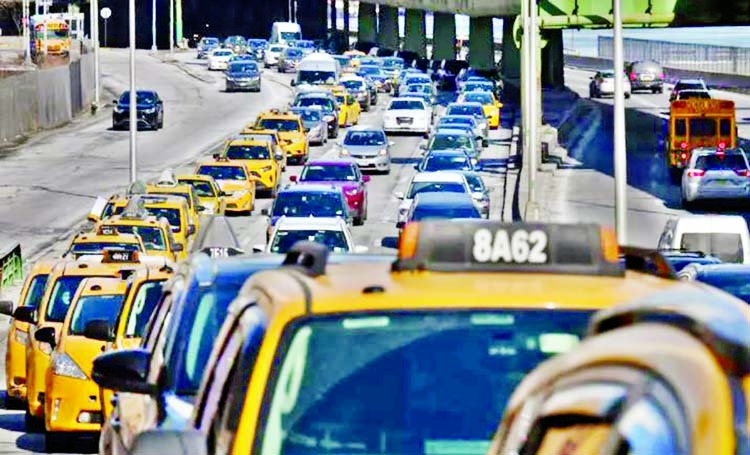
AFP :
They were omnipresent on the streets of New York day and night, as emblematic of the Big Apple as the Empire State Building or Yankees caps. But the pandemic has made yellow taxis scarce and facing an uncertain future.
On a February morning in a parking lot near La Guardia Airport, a few dozen of the yellow cabs patiently queue in the freezing cold to catch a fare from one of the terminals.
“This lot used to be full with hundreds of cabs and even a line outside,” says 65-year-old Joey Olivo, recalling the days before coronavirus.
“Now there is only about 50 and you wait two hours, when before you’d wait 20 minutes,” adds Olivo, a taxi driver for three decades.
Widespread working from home, school closures and no tourists means rides have plummeted for Olivo, as they have for all of New York’s cabbies.
“It’s been pretty bad. My earnings dropped 80 percent. I went from making maybe $1,000 a week to making two or 300 dollars a week,” he told AFP.
Olivo, who lives in Brooklyn, is trying to put a brave face on his situation, joking that he is lucky his wife “makes good money” as a nurse, otherwise “I would have had a rope around my neck.” Free fall New York taxi drivers, most of whom are first-generation immigrants, were once able to make $7,000 a month or more if they worked long hours seven days a week.
Competition from Uber, Lyft and other vehicle-for-hire firms had already drastically dented their income, but with the pandemic it is in “free fall,” says Richard Chow, a 62-year-old taxi driver originally from Myanmar.
Chow is not feeling the press as much as most, because he bought his license, called a “medallion” in New York, for $410,000 in 2006.
In the years that followed, medallion prices soared, inflated by a nexus of bankers, investors and lawyers.
In 2009, his younger brother Kenny Chow paid $750,000 for his license. In 2014, the cost of medallion reached $1 million.
The arrival of thousands of new drivers working for Uber and others has caused the medallion bubble to burst and condemned thousands of cabbies who had bought medallions at a high cost on credit to fall into debt or bankruptcy.
Kenny Chow and at least seven other drivers, including of black cars and limousines, committed suicide in 2018, underscoring a dire situation that has been worsened by the pandemic.
“The pandemic has just been devastating,” said Bhairavi Desai, executive director of the Taxi Workers Alliance.
“Before the pandemic, ridership had been down by 50 percent. Since the pandemic, it’s down closer to 90 percent,” she told AFP.
“The parts of the city that are the most deserted are the parts of Manhattan where drivers depend on in order to earn their living, and the airports,” Desai added.
Hence the scarcity of yellow taxis. Out of some 13,000 licenses, only about 5,000 taxis are running regularly at the moment, according to the union.
Some 7,000 others aren’t even leaving their garages. According to William Pierre, a driver from Haiti, it is no longer profitable.
He continues to drive even though his daily earnings barely exceed $100 to $150, which he shares 50/50 with the company that leases the car to him.
“I don’t want to stay home. I want to be out there to feed my family,” he says.
So could the yellow taxis, which replaced checkered-striped cabs in the 1960s, actually disappear?
Cultural icon
Olivo and Pierre believe business will pick up eventually, even though they agree it will never be the same again.
Desai fears yellow cabs “will slowly phase out” if the city government does not erase drivers’ debts.
Her union is stepping up protests and dozens of drivers briefly blocked traffic on the Brooklyn Bridge on Wednesday.
“You know you are in NYC when you see that yellow,” says Desai, adding that the taxis are famous the world over.
“It’s a cultural icon… a 24-hour service that is part of the economic, social and cultural fabric of our beautiful city.”
New York’s Democratic mayor, Bill de Blasio, has promised to help the taxi drivers provided the city, economically ravaged by the pandemic, is bailed out by the federal government.
“If we can get the kind of stimulus support we deserve. I think it opens the door to coming up with a solution to help taxi drivers and families who have suffered so much,” he said on Wednesday.

